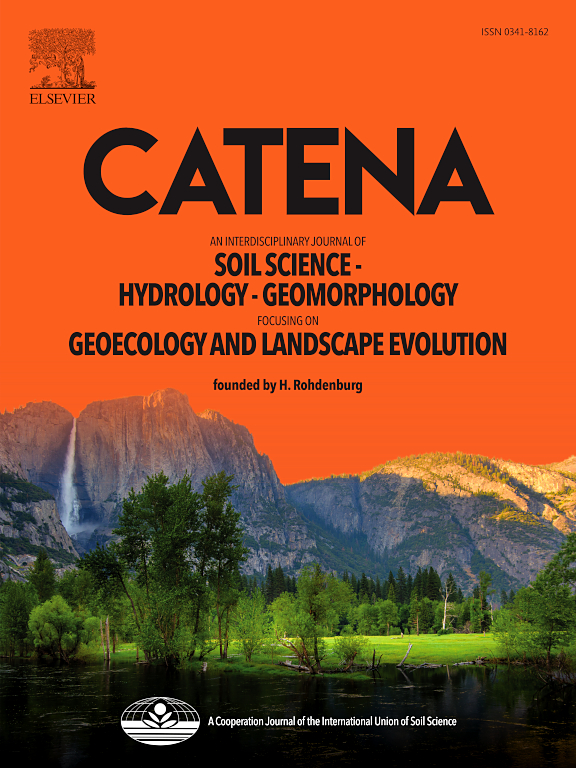中国高纬度温带森林树木多样性相关的土壤磷积累受土壤C、N含量以及微生物网络和反硝化基因的调控
IF 5.4
1区 农林科学
Q1 GEOSCIENCES, MULTIDISCIPLINARY
引用次数: 0
摘要
树木多样性被认为是增强土壤功能的自然解决方案,但其对磷(P)保持动态的影响仍知之甚少。我们分析了33个与碳(C)、氮(N)和磷循环相关的参数,以及642个微生物功能基因,跨越3个树木丰富度梯度;中国东北有60年历史的实验森林。主要研究结果表明:1)树木丰富度的增加使土壤总磷(TP)增加了1.34倍,同时使浓cl -可提取有机磷(con . cl - po)、浓naoh -可提取有机磷(NaOH-Po)和浓nahco3 -可提取无机磷(NaHCO3-Pi)增加了1.34 ~ 1.83倍。有机磷(占总磷的60%)和中低植物有效磷组分随树木丰富度呈线性增加(r2 = 0.1049, P <;高效磷无显著变化趋势。2)树的丰富度提高了微生物网络的复杂性,增加了网络度(7 - 85%)、总边数(7 - 10%)和模块化(37 - 85%),减少了节点间路径长度(13 - 17%)。变形菌群丰度从23%线性下降到20%。3)硝态氮(NO3−-N)、全氮(TN)和速效氮(AN)与P组分的相关性强于与c组分的相关性。4)硝酸盐还原基因是C-N-P动力学的关键调控因子:napB(周质硝酸盐还原酶)作为正调控因子(解释力5.2%),而narB(同化性硝酸盐还原酶)作为负调控因子(解释力15.1%)。这些结果表明,树木多样性通过微生物群落重组和功能基因调节促进高纬度森林土壤磷的保持和循环,类似于其在碳和氮固存中的作用。我们的工作为温带森林生态系统中生物多样性驱动的营养调节提供了机制见解。本文章由计算机程序翻译,如有差异,请以英文原文为准。

Tree diversity-related soil P accumulation in high latitude temperate forests of China is regulated by soil C and N amounts as well as microbial network and denitrification genes
Tree diversity is recognized as a nature-based solution for enhancing soil functionality, yet its impact on phosphorus (P) retention dynamics remains poorly understood. We analyzed 33 parameters related to carbon (C), nitrogen (N), and P cycling alongside 642 microbial functional genes across three tree richness gradients in > 60-year-old experimental forests in northeastern China. Key findings revealed: 1) Higher tree richness increased total soil phosphorus (TP) by 1.34-fold, with concomitant 1.34–1.83-fold increases in concentrated HCl-extractable organic P (conc.HCl-Po), NaOH-extractable organic P (NaOH-Po), and NaHCO3-extractable inorganic P (NaHCO3-Pi). Organic P (accounting for 60 % of TP) and medium to low plant-available P fractions exhibited linear increases with tree richness (r2 = 0.1049, p < 0.05), whereas highly plant-available P showed no significant trend. 2) Tree richness enhanced microbial network complexity, increasing network degree (7–85 %), total edges (7–10 %), and modularity (37–85 %), while reducing inter-node path length (13–17 %). Proteobacteria abundance declined linearly from 23 % to 20 %. 3) Nitrate (NO3−-N), total N (TN), and available N (AN) demonstrated stronger correlations with P fractions than C-related parameters. 4) Nitrate reduction genes emerged as critical regulators of C-N-P dynamics: napB (periplasmic nitrate reductase) acted as a positive modulator (5.2 % explanatory power), while narB (assimilatory nitrate reductase) functioned as a negative regulator (15.1 % explanatory power). These findings demonstrate that tree diversity enhances soil P retention and cycling in high-latitude forests through microbial community restructuring and functional gene modulation, similar to its roles in C and N sequestration. Our work provides mechanistic insights into biodiversity-driven nutrient regulation in temperate forest ecosystems.
求助全文
通过发布文献求助,成功后即可免费获取论文全文。
去求助
来源期刊

Catena
环境科学-地球科学综合
CiteScore
10.50
自引率
9.70%
发文量
816
审稿时长
54 days
期刊介绍:
Catena publishes papers describing original field and laboratory investigations and reviews on geoecology and landscape evolution with emphasis on interdisciplinary aspects of soil science, hydrology and geomorphology. It aims to disseminate new knowledge and foster better understanding of the physical environment, of evolutionary sequences that have resulted in past and current landscapes, and of the natural processes that are likely to determine the fate of our terrestrial environment.
Papers within any one of the above topics are welcome provided they are of sufficiently wide interest and relevance.
 求助内容:
求助内容: 应助结果提醒方式:
应助结果提醒方式:


